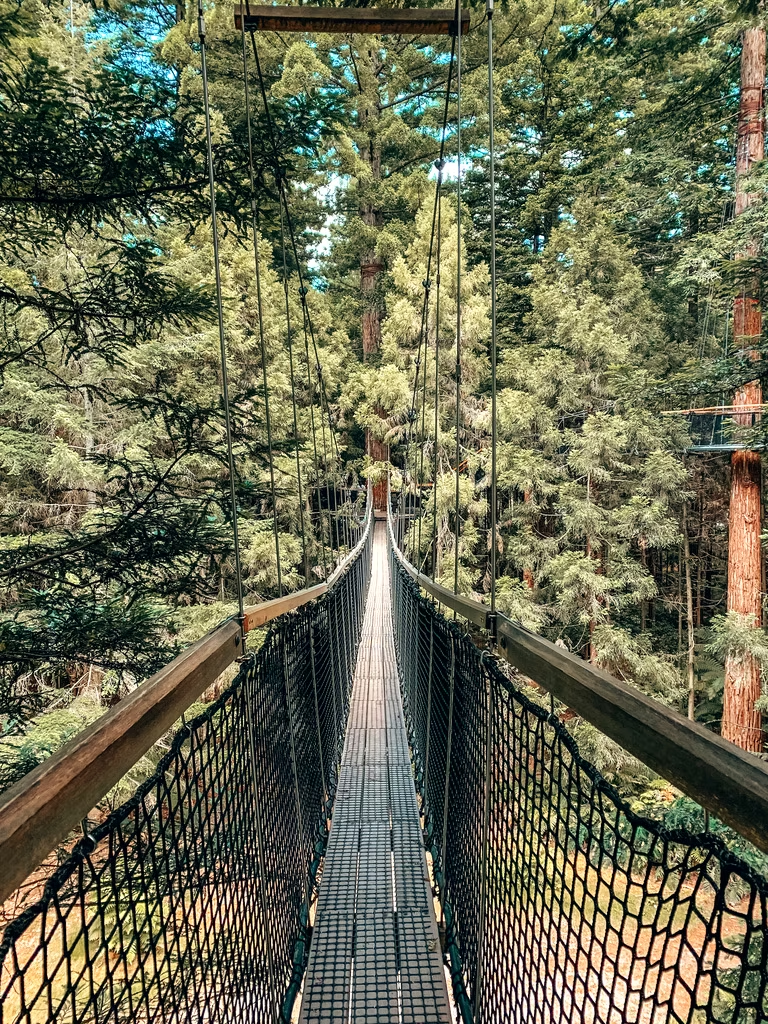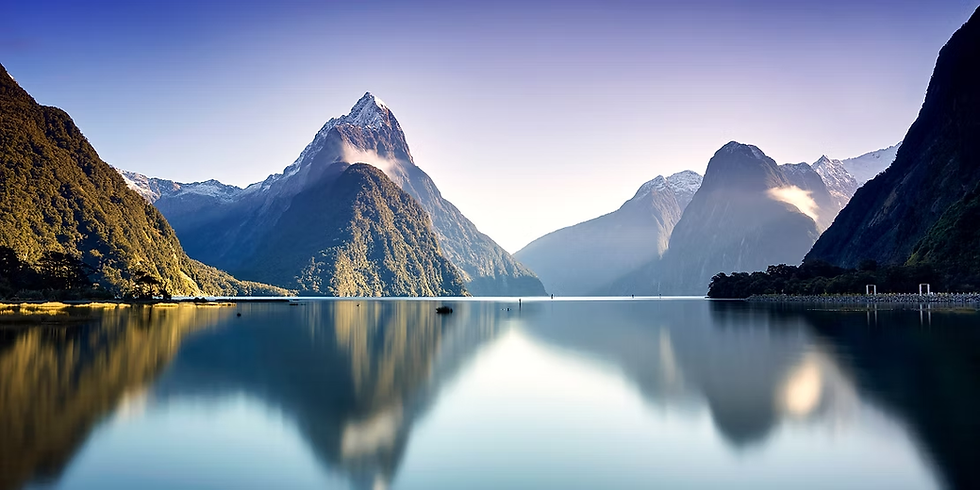IN THE SHADOW OF THE GIANTS, THE WHAKAREWAREWA FOREST
- angelogeorge988
- Jul 2
- 6 min read
Not all forests are created equal. Some whisper, others scream. But the Redwoods – Whakarewarewa Forest in Rotorua whispers tales from a parallel world, where time crawls among ancient trunks and the air seems distilled from nature’s own poetry. As you step into the forest, civilization dissolves. The giant trees, brought from California in the early 20th century, have acclimatized and become the spiritual guardians of this New Zealand sanctuary. Though not native, they feel at home—and for a moment, so do you, as part of the landscape. The suspended walkway through the majestic trees is a dance of gravity. Bridges strung between towering trees at dizzying—yet gentle—heights offer a cinematic perspective of the forest. At night, artistic lighting transforms the place into an enchanted woodland, where light and shadow forge a pact with fantasy. But what makes this forest truly special is how it weaves nature’s resilience with human history. Nearby lie sacred Māori sites, and the air feels charged with the memory of a culture that understood: man does not dominate nature—he merely coexists with it.

Under the Sacred Sign of Māori Civilization
Around the forest, where trees rise like columns of a vegetal cathedral, the earth trembles with a memory older than time. The sacred Māori sites are not merely places—they are the breath of ancestors, hidden among geothermal mist and leaf-shadow. It is said that the fire goddesses, Te Hoata and Te Pupu, journeyed from Hawaiki, leaving behind hot springs, geysers, and lakes that still speak. And the forest, in its solemn silence, holds the footprints of the warrior Wāhiao, who, veiled by the earth’s steam, led an army in a Haka dance just before battle. The forest does not forget—it preserves, in its fibers, the songs, sorrows, and hopes of those who lived here: Ngāti Wāhiao and Tūhourangi, tribes who survived the devastating eruption of Mount Tarawera and transformed suffering into continuity.

The Silent Cathedral
We are here, in the heart of the forest. The air is dense, almost solemn, and each step seems to extinguish the noise of the world. Children run ahead, their laughter dissolving among the towering trunks. The forest is frozen in stillness, and the redwoods, hard as steel, rise perfectly toward the sky like cathedral columns. We look up and feel as if we’re inside an endless Gothic structure. Light filters through the leaves with reverence, like through the stained glass of an old church. I think of Brașov and the Black Church, but here there is no stone—only living wood. Everything breathes, but in silence. It is a vegetal sanctuary. We listen closely to the rustling leaves. This is not just nature—it is a story. A story of verticality, of freedom, and of silence that seeks no approval. Here, grand words are unnecessary. Only presence matters.

In the Arboreal Dome
We walk in silence, and the leaves rustle with a reverence that asks for no reply. The children—usually eager for play and noise—are overwhelmed by the beauty that surrounds them. They gaze around with wide eyes, like pilgrims arriving at a wondrous place. Each Redwood trunk is a column in a living church. Their shadows fall with precision, almost mathematical, yet with the gentleness of an embrace. We move slowly toward the heart of the forest, where the silence deepens—not as an absence of sound, but as a presence of eternity. Beneath this vegetal dome, we feel sheltered from all that is unstable in the world. From the rush of cities, from news that bites into hope, from memories that haven’t yet healed. Here, nature raises walls without hostility, offering refuge and time. It is a lesson without words, because sometimes silence is the clearest form of understanding. And the children know this now, even if they cannot explain it. When we breathe in sync with the forest, it feels as though we’ve returned, for a moment, to something older than history.

Rocko, the Stone Serpent
In the heart of the forest, among trees so tall they seem to touch the clouds, lives a legendary creature—Rocko, the stone serpent, toward whom we walk with curiosity. It is said he’s not made of scales, but of painted dreams. Each stone in his body is a testament: of a family who came with their children, of an artist who wanted to leave a mark, of a wandering soul who found a drop of solace among the trees. Rocko was not born—he was shaped by the hands of the community, growing with every kind thought, every splash of colour cast upon granite. When the forest heats under the sun’s rays and Mokopuna becomes a trail of light, Rocko glows in a thousand hues, like a pacifist dragon guarding the bond between people and nature. Some say that if you sit beside him long enough, you can hear the music of the earth—a symphony of footsteps, laughter, and wind. Others believe his stones tell stories, and those who touch them with an open heart may understand that true resilience does not come from strength, but from continuity—from an art that refuses to surrender to forgetting.

This is how, at a gentle bend in the path, the silent serpent reveals itself—alive through collective memory. The children see it first and stop, astonished, as if before a mythical creature. Its length is almost unbelievable, its undulating body made of hundreds, perhaps thousands, of painted stones—each one a story, a drawing, a personal imprint left by visitors who felt the call of the place. They stand and stare, mesmerized by the colorful trail of stones, for minutes on end, without saying a word. We begin to follow it with our eyes, as if it’s leading us toward the forest’s core, in a ritual without words. The stones are cheerful, somber, abstract, childlike—a gallery under open sky, born from the human impulse to leave something behind. To me, Rocko is not just a playful symbol. He is an act of creative resistance. A form of free expression, unfiltered, unafraid of censorship. He is visceral—just like the Metal lyrics scribbled on notebook corners during the dark days of communism.

The Living Columns of the Forest
Among the living columns of Whakarewarewa Forest stretches a 700-meter aerial path—the Redwoods Treewalk, an ecological stroll that asks only for presence and wonder. Twenty-eight suspended bridges link twenty-seven Redwood trees, each over 117 years old, in a silent dance of balance and respect for nature. No harnesses, no instructions—just footsteps and upward gazes. Twenty meters above the ground, the forest ceases to be mere scenery—it becomes a cathedral. Its innovative suspension system, unique in New Zealand, protects the trees without touching them—like an unspoken promise between humanity and nature.

Tickets can be purchased from the Redwoods i-SITE and Visitor Centre, and gift cards are available on the official Treewalk website and in the souvenir shop.

The Suspended Symphony
We step gently onto the aerial path, and the first bridge feels like an arc drawn across the forest’s breath. Beyond it stretch the remaining 27, like verses from a poem etched in wood, lifting us above the ground, where leaves are no longer mere details—they become the ceiling of a green sanctuary. The Redwood trees, those superb colossi, welcome us with gentle solemnity.

We do not oppose gravity—we negotiate with it, elegantly. We do not climb—we float. The structure of the bridges, delicately held by an innovative system that neither touches nor harms the trees, feels more like a gesture of reverence than of engineering. Nothing disturbs this ancient balance—not our footsteps, nor the curious breath of children.

Even the rain is welcome here. Colours intensify, and the leaves seem to sing in shades of green and silver. Children step with shyness, adults with reverence. Each bridge is a stanza, each platform—a breath’s pause. In rainy weather, the forest wears deeper hues, as if nature had passed through a pure vinyl filter, emphasizing detail and reverberation. The raindrops don’t shake—they embrace. You can walk at your own rhythm, no harnesses, no instructions—like a soloist stepping onto the stage, already knowing the score by instinct.

The Final Step Toward Light
The panels speak, but they also listen. They tell you about the forest’s past, about the pioneers who brought the trees, about the dream of connecting humans with height—without conquering it. It’s an experience both sensory and spiritual, where the entire family becomes part of an ecological procession. On this path, you don’t descend from the forest. You rise into it. And at the end of the trail, where the forest seems to gently erase its footprints from the present, you’re left with a silence you’ve learned and a gaze trained to look upward. The bridges remain behind like thoughts that carried us through heavy days—suspended, yet real. Redwoods Forest is not just a walk. It is a vertical score, a silent prayer lifted in simple steps, a lesson in how to move without disturbing, how to feel without shouting. It is an ecological cross between past and possible, where each tree is an altar and each visitor—a pilgrim unknowingly reclaiming a lost part of themselves. And when you leave, the forest does not release you. It keeps you—somewhere between branches and memories.




Comments